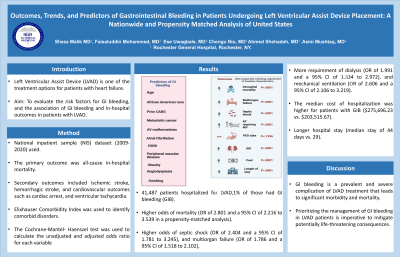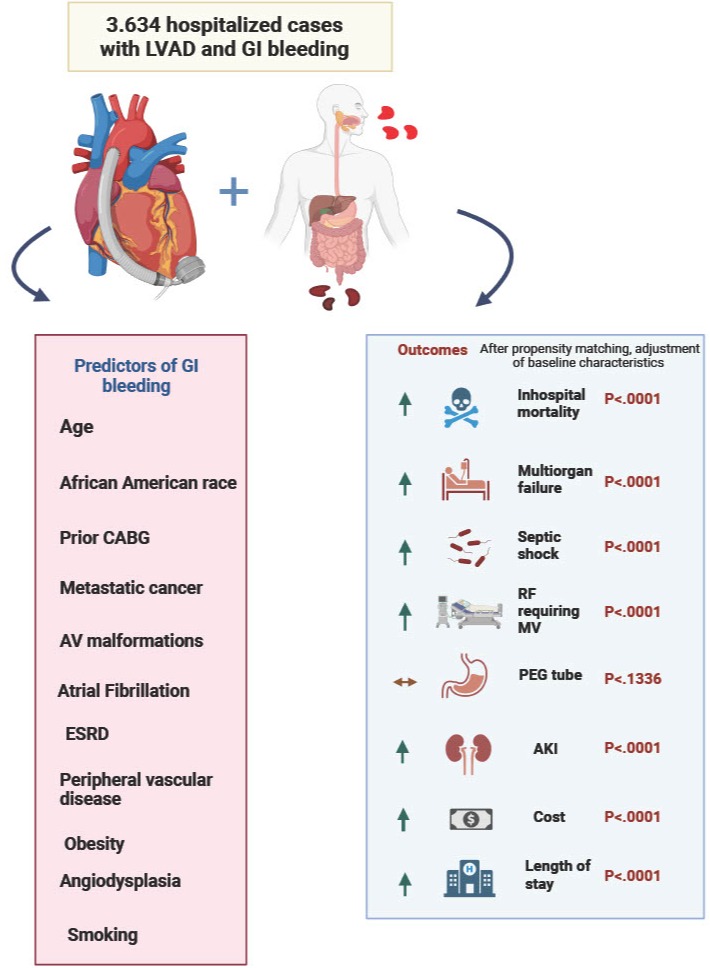Tuesday Poster Session
Category: GI Bleeding
P3459 - Outcomes, Trends, and Predictors of Gastrointestinal Bleeding in Patients Undergoing Left Ventricular Assist Device Placement: A Nationwide and Propensity Matched Analysis of United States
Tuesday, October 24, 2023
10:30 AM - 4:00 PM PT
Location: Exhibit Hall

Has Audio
- SM
Sheza Malik, MD
Rochester General Hospital
Rochester, NY
Presenting Author(s)
Sheza Malik, MD, Faisaluddin Mohammed, MD, Ese Uwagbale, MD, Chengu Niu, MD, Ahmed Shehadah, MD, Asim Mushtaq, MD
Rochester General Hospital, Rochester, NY
Introduction: Left Ventricular Assist Device (LVAD) is one of the treatment options for patients with heart failure. In this study, we inspected the risk factors for Gastrointestinal(GI) bleeding, and the association of GI bleeding and in-hospital outcomes in patients with LVAD.
Methods: We conducted a study using population from the national inpatient sample (NIS) dataset (2009-2020). The study cohort used was from the international classification of disease, 9th and 10th revision, clinical modification ICD-9, and 10-CM codes to identify patients 18 years of age and up. The primary outcome was all-cause in-hospital mortality. Secondary outcomes included ischemic stroke, hemorrhagic stroke, and cardiovascular outcomes such as cardiac arrest, and ventricular tachycardia. Elixhauser Comorbidity Index was used to identify comorbid disorders. The Cochrane-Mantel- Haenszel test was used to calculate the unadjusted and adjusted odds ratio for each variable.
Results: We identified a total of 41,487 patients hospitalized for LVAD. 1% of those had GI bleeding (GIB) Patients with and without GIB had similar median age (61 vs 58). The two groups were predominantly male and Caucasian (73.45% vs 76.31%) and (95% vs 62%) respectively. LVAD patients who experienced GIB had higher odds of mortality compared to those who did not (with an OR of 2.801 and a 95% CI of 2.216 to 3.539 in a propensity-matched analysis). Additionally, the LVAD group of patients with GIB had higher odds of septic shock (with an OR of 2.404 and a 95% CI of 1.781 to 3.245), AKI (OR of 1.990 and a 95% CI of 1.680 to 2.357), and multiorgan failure (OR of 1.786 and a 95% CI of 1.518 to 2.102) compared to those without GIB. The GIB group also had higher odds of requiring dialysis (with an OR of 1.991 and a 95% CI of 1.334 to 2.972), and mechanical ventilation (with an OR of 2.606 and a 95% CI of 2.106 to 3.219). The median cost of hospitalization was higher for patients with GIB (with a cost of $275,696.23 compared to $203,515.67 for those without GIB), and their hospital stay was longer (with a median stay of 44 days compared to 29 days for those without GIB).
Discussion: The occurrence of GI bleeding is a prevalent and severe complication of LVAD treatment that leads to significant morbidity and mortality. Consequently, prioritizing the management of GI bleeding in LVAD patients is imperative to mitigate potentially life-threatening consequences.

Disclosures:
Sheza Malik, MD, Faisaluddin Mohammed, MD, Ese Uwagbale, MD, Chengu Niu, MD, Ahmed Shehadah, MD, Asim Mushtaq, MD. P3459 - Outcomes, Trends, and Predictors of Gastrointestinal Bleeding in Patients Undergoing Left Ventricular Assist Device Placement: A Nationwide and Propensity Matched Analysis of United States, ACG 2023 Annual Scientific Meeting Abstracts. Vancouver, BC, Canada: American College of Gastroenterology.
Rochester General Hospital, Rochester, NY
Introduction: Left Ventricular Assist Device (LVAD) is one of the treatment options for patients with heart failure. In this study, we inspected the risk factors for Gastrointestinal(GI) bleeding, and the association of GI bleeding and in-hospital outcomes in patients with LVAD.
Methods: We conducted a study using population from the national inpatient sample (NIS) dataset (2009-2020). The study cohort used was from the international classification of disease, 9th and 10th revision, clinical modification ICD-9, and 10-CM codes to identify patients 18 years of age and up. The primary outcome was all-cause in-hospital mortality. Secondary outcomes included ischemic stroke, hemorrhagic stroke, and cardiovascular outcomes such as cardiac arrest, and ventricular tachycardia. Elixhauser Comorbidity Index was used to identify comorbid disorders. The Cochrane-Mantel- Haenszel test was used to calculate the unadjusted and adjusted odds ratio for each variable.
Results: We identified a total of 41,487 patients hospitalized for LVAD. 1% of those had GI bleeding (GIB) Patients with and without GIB had similar median age (61 vs 58). The two groups were predominantly male and Caucasian (73.45% vs 76.31%) and (95% vs 62%) respectively. LVAD patients who experienced GIB had higher odds of mortality compared to those who did not (with an OR of 2.801 and a 95% CI of 2.216 to 3.539 in a propensity-matched analysis). Additionally, the LVAD group of patients with GIB had higher odds of septic shock (with an OR of 2.404 and a 95% CI of 1.781 to 3.245), AKI (OR of 1.990 and a 95% CI of 1.680 to 2.357), and multiorgan failure (OR of 1.786 and a 95% CI of 1.518 to 2.102) compared to those without GIB. The GIB group also had higher odds of requiring dialysis (with an OR of 1.991 and a 95% CI of 1.334 to 2.972), and mechanical ventilation (with an OR of 2.606 and a 95% CI of 2.106 to 3.219). The median cost of hospitalization was higher for patients with GIB (with a cost of $275,696.23 compared to $203,515.67 for those without GIB), and their hospital stay was longer (with a median stay of 44 days compared to 29 days for those without GIB).
Discussion: The occurrence of GI bleeding is a prevalent and severe complication of LVAD treatment that leads to significant morbidity and mortality. Consequently, prioritizing the management of GI bleeding in LVAD patients is imperative to mitigate potentially life-threatening consequences.

Figure: Predictors and Outcomes of GI Bleeding in LVAD Patients
Disclosures:
Sheza Malik indicated no relevant financial relationships.
Faisaluddin Mohammed indicated no relevant financial relationships.
Ese Uwagbale indicated no relevant financial relationships.
Chengu Niu indicated no relevant financial relationships.
Ahmed Shehadah indicated no relevant financial relationships.
Asim Mushtaq indicated no relevant financial relationships.
Sheza Malik, MD, Faisaluddin Mohammed, MD, Ese Uwagbale, MD, Chengu Niu, MD, Ahmed Shehadah, MD, Asim Mushtaq, MD. P3459 - Outcomes, Trends, and Predictors of Gastrointestinal Bleeding in Patients Undergoing Left Ventricular Assist Device Placement: A Nationwide and Propensity Matched Analysis of United States, ACG 2023 Annual Scientific Meeting Abstracts. Vancouver, BC, Canada: American College of Gastroenterology.
